(a digressive return to Barrow in breeze and sun)
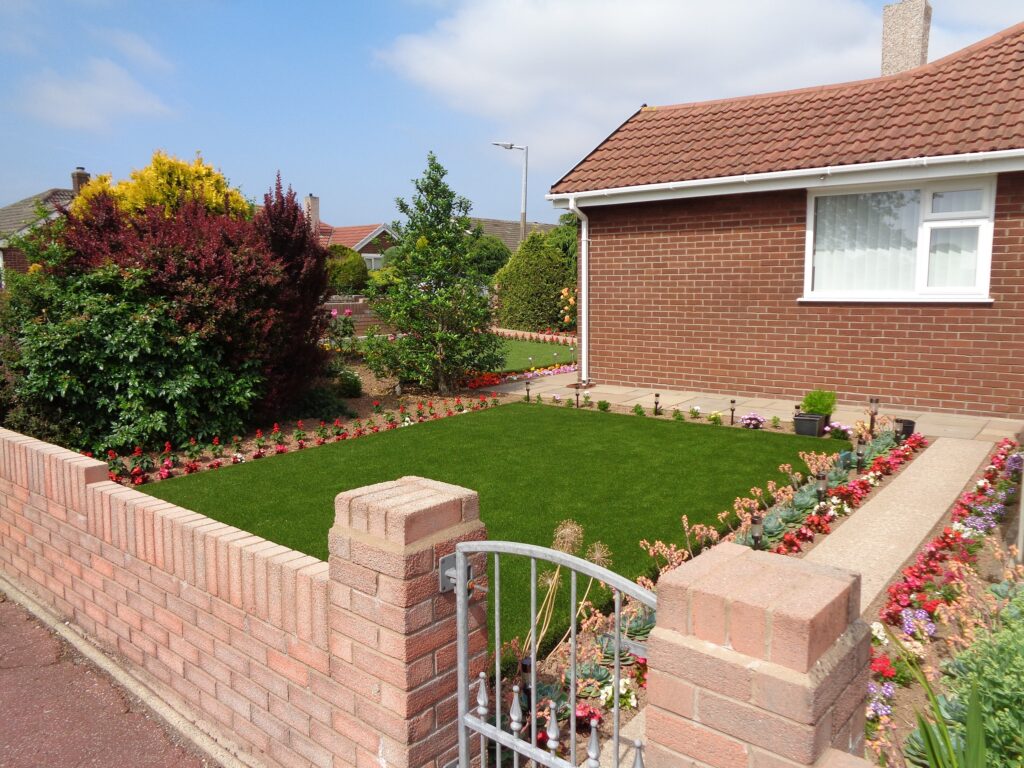
Paradise in AstroTurf, 30th June 2021
To appreciate or try to elevate the apparently inconsequential isn’t, I hope, akin to taking refuge in that contemporary relativism which allows everyone to be entitled to their opinion no matter how unearned or ill considered. Equally, there is no doubt that the perception of this ‘inconsequential’ can be highly personal – perhaps to the point of incommunicability?
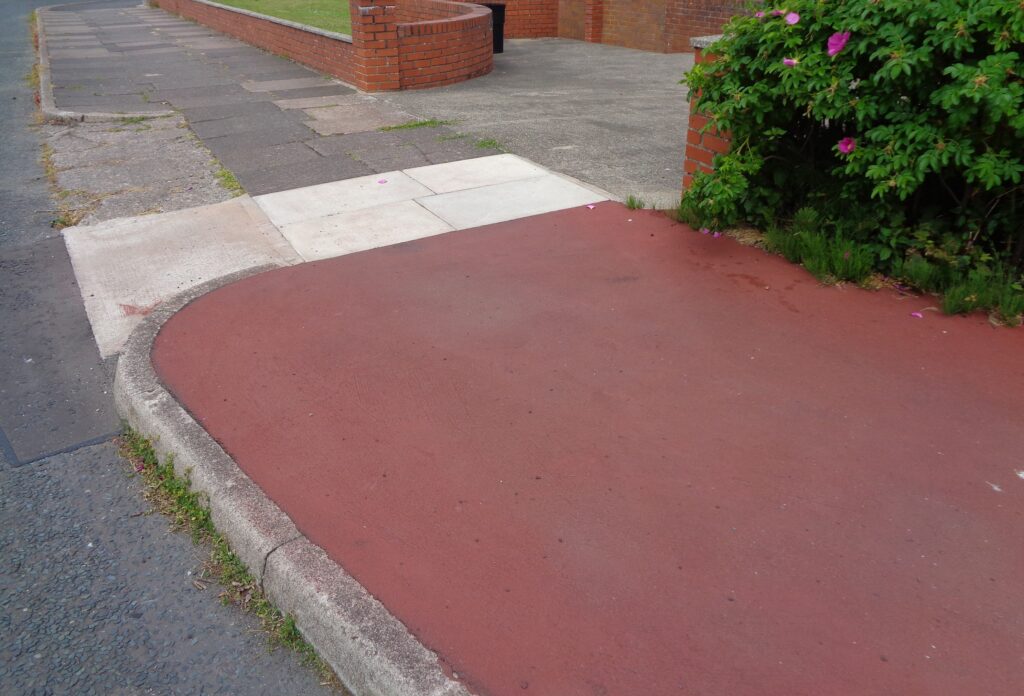
Red Ochre Bluff, 30th June 2021
Returning to Barrow-in-Furness in very different conditions to October last year[i], I was overwhelmed by this sense of incommunicability – yet also by the almost visionary significance lurking behind the everyday. Or so it felt. Later, sending a few of the resulting photographs to four friends, their reactions were not encouraging:
The estate looks like hell on earth! You are suffering from future dementia!!!
These photos are too much of a gimmick, you’ll come across as a nutter.
Do they really tell a story? And if so what is it? More to the point, does it matter that much? Overall, they just make me really sad. Is this really the best that life has to offer?
Too inconsequential to be worth bothering with. Anyone who didn’t grow up in the 70s won’t get it, and for the people who live there now, it’s just their reality.

The Unseen Path, 13th August 2021
Of course, these relatively off-the-cuff or caustically humorous remarks, were provoked by a handful of images without context. My friends did not have the benefit of the actual atmosphere. Of the hot, mid-morning, of June 30th, slightly overcast now and then, or the fresh breeze and more consistent sun of August the 13th . . . a Friday which proved auspicious. Nor is it likely they share my enigmatic love and sense of loss for certain kinds of suburb rooted in the late 60s and early 70s . . . In fact, one of the four, loathes almost everything about the 70s. Barrow’s Hawcoat estate evoked the restrictions of her lower middle-class, East Devon childhood in a way too close for comfort. By contrast, the largely working class, council-built, Elmhurst estate on the edge of Aylesbury where I grew up from 1966 to 1979 – inhabited mostly by “London overspill” – was less inhibiting.
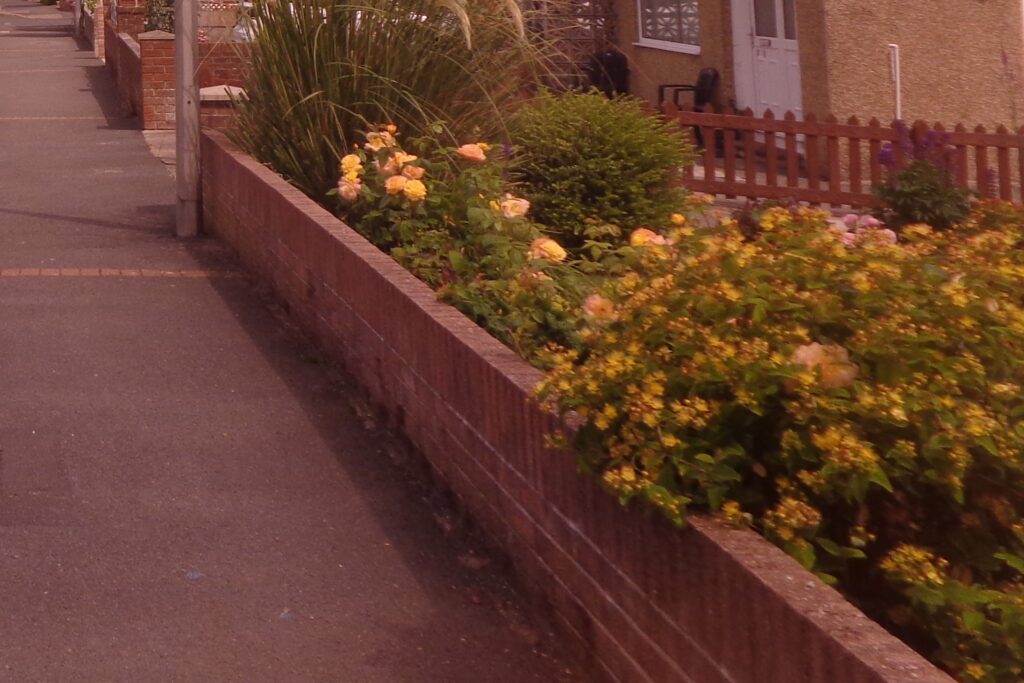
Pavement Magnetism
Hawcoat is the kind of estate to which the more ambitious inhabitants of Elmhurst would have aspired. A dream of easy Sunday dinners, model railways in the garden, lawnmowers you didn’t have to push and early retirement. Naturally some sections of Hawcoat, 50 years later, have gone to seed, been over-renovated or rationalised out of existence, but between the circumscribed slopes or flats of grass, gravel and patio and the weed-blown desolation of abandonment, immaculate borders and shrubs also flourish, and, in the summer of 2021, both an Austin A30 and a Morris Minor convertible, could be seen, glinting in the sun as if they’d just been driven from the factory. One even bowled past in time-denying motion.
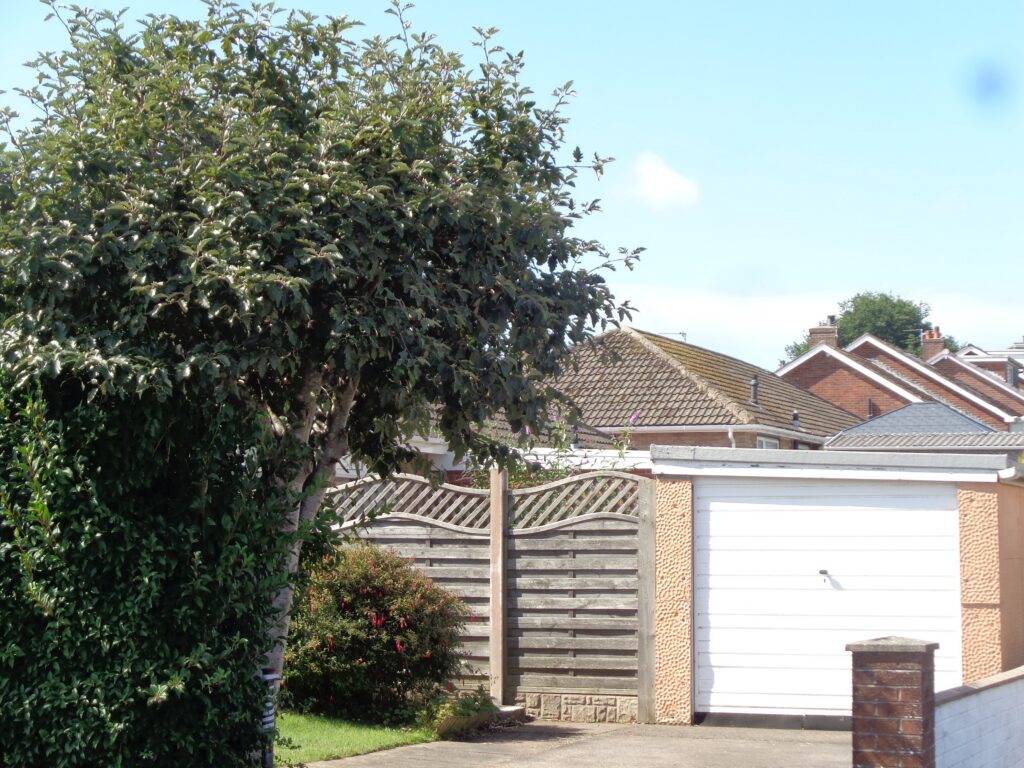
A late Zephyr, breezes through the fencing . . . 13th August, 2021
Almost every time I go out, especially in the sun, I suffer or enjoy (as I get older, mostly enjoy) an atmosphere overload. Moors, mountains, coast, fields, or suburbs – it can strike anywhere and at any time. In built-up areas or in the ribbon agglomerations of buildings which follow the older main roads, I used to name this excessive feeling, the London Atmosphere. For years, I never questioned the vagueness of this default label: both its possible meaning and the baffling intensity behind its sensation, were impossible to bring into focus. Since this was never the London of Tower Bridge or Trafalgar square or even of the Thames, the title could only be personal. Some left-over, unattached perception felt or experienced when I was three or four, under the flyovers, before my family moved from London: an escape perhaps; a tiny garden filled with flowers; the outside area of a pub; that door in the wall[ii].
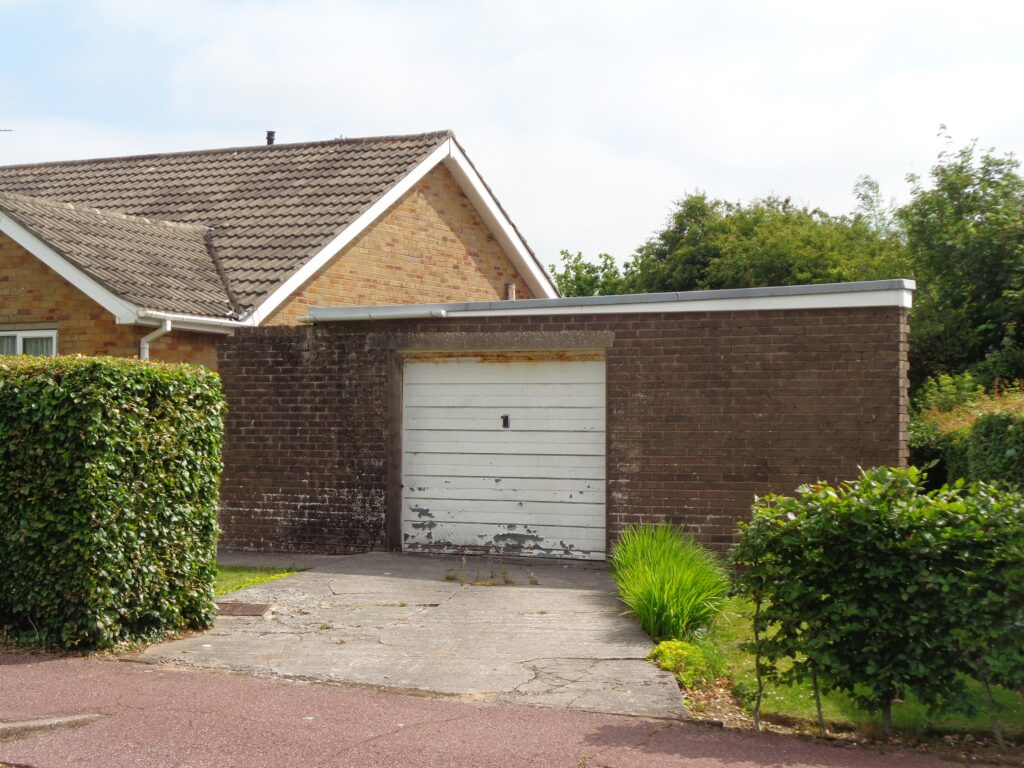
Door in the Wall: the garage that wasn’t there, 30th June 2021
I tend to be sceptical of memories people claim from under the age of five. Or maybe I just don’t have that desire or need to be so specific about pain? Traumatic events generally don’t stick to me, at least not consciously. Only the enigmatic and the inexplicable, those intuitions of timelessness . . . only these continue to haunt.
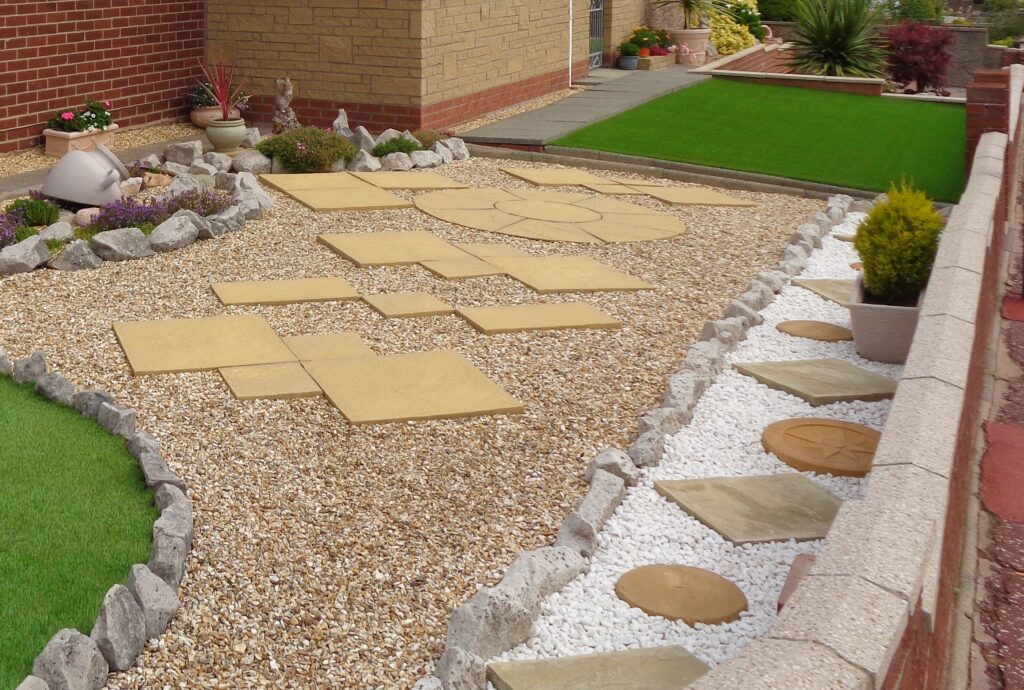
Greco-Zen(ish) rock garden/AstroTurf patio, Hawcoat estate, Barrow 30th June 2021
That special ‘London feeling’ was very striking, yet perhaps some calmness of the eternal was contained within its overflow? Do the Hawcoat versions, almost of Zen rock gardens contain something similar or are they its antithesis? All restraint, rather than excess? Desire excised?
To excise desire either as a general principle or as a move towards Nirvana, feels to me an error – surely excess desire is the best route to eventual calmness? But such persuasions could depend on individual temperament. Both the richness of the past and of history, for me only increase over time, even as their apparent opposite – visionary detachment (a rising above desire, or simultaneous experience of all desire, rather than a purging of it) – increases also.
As for the London feeling, its enigmatic history, social and architectural within the Green Belt; within the pre-war, wartime and post-war reminiscences of elders with which I was (interestingly) bombarded as a child; within Europe and the wider context of the decline of empires . . . That London feeling must have been drawn from all this and named after where I assumed the magic was situated. But I was wrong. The magic is universal and everywhere, you just need to be attuned to it – your own. It’s fair enough if you hate the idea of the place behind these photos.

Time and peace: blue bush and serrated sky, Barrow (Hawcoat estate), 30th June 2021
Perhaps an Aylesbury feeling is the basis of my love of housing estates? There, in the early 70s, I did several paper rounds. Mostly covering for friends, they never had a chance to become routine and I tend to remember them in holiday weather. Ideal journeys through unfamiliar streets. Streets so close to ours yet beyond the usual circuit.
After fifteen to twenty minutes selling the Evening Standard[iii] in a factory canteen off the Bicester road during the worker’s afternoon break, one such round, went on to tour a chance collection of stairways, alleys and closes mostly on the Quarrendon housing estate. Another, with bigger newspapers and colour supplements, took me to the opposite extreme in the undoubted stratification of Aylesbury’s housing estates: the posh-at-the-time, Bedgrove. Though it had prosaic sections, the never-council-owned Bedgrove, even boasted detached villas with (apparent) stone column entrance porches. Actually, they were hollow.
Between 1966 and 1979, all the large housing estates had a place in some informal league table in the collective unconscious of the denizens of Aylesbury – though whether this table would’ve been supported by statistics, I can’t say.
Southcourt, partly built in the 20s for veterans of the First World War and offered as “Homes for Heroes” was expanded further after the Second World War and vied for lowest position with Quarrendon, a 50s development not extended until thirty years later. Elmhurst, where we moved to as the first occupiers in March 1966 – was perhaps a little higher up the table? Prebendal Farm, a 70s estate, seemed good to me when a friend moved there just after its construction . . . but apparently it declined[iv]. Walton Court (1970-80s) appeared a further step towards the promised land – at least at that time.
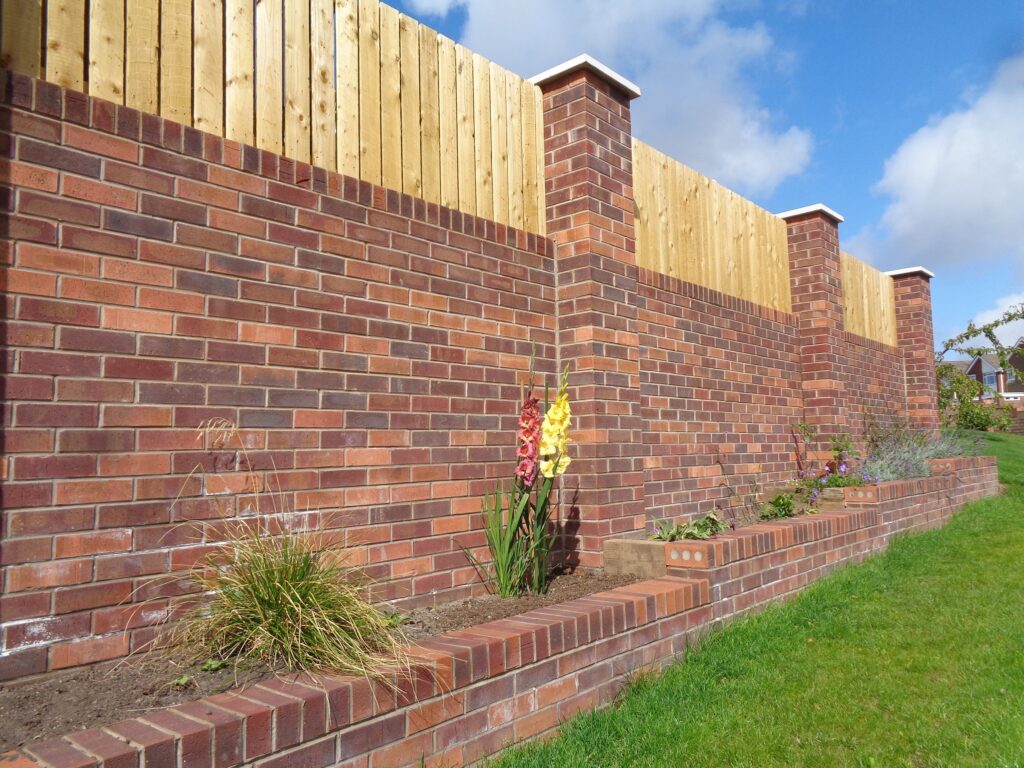
This Transient Life . . . 13th August 2021
Fragmented by its own interior traumas, Akio Jissôji’s 1970 film, Mujô (English title: This Transient Life[v]), uses artistic imperative and taboo sexual passion to challenge the confines of tradition and question the ambiguities of religious philosophy. The camera moves and tracks in a way both precise and impetuous – echoing the apparent contradiction of the Zen rock gardens on which it occasionally focuses. Gardens which attempt to express the essence of nature in a way that can appear ascetic, mathematical, almost airless . . . yet suggestively poetic at the same time. Whether such gardens induce calm, or agitation, may also depend on your temperament?
On the Hawcoat estate, quite a few gardens appeared to be (inadvertently?) aiming for something similar, albeit mixed with elements from other traditions as well as pre-cast concrete slabs and AstroTurf!
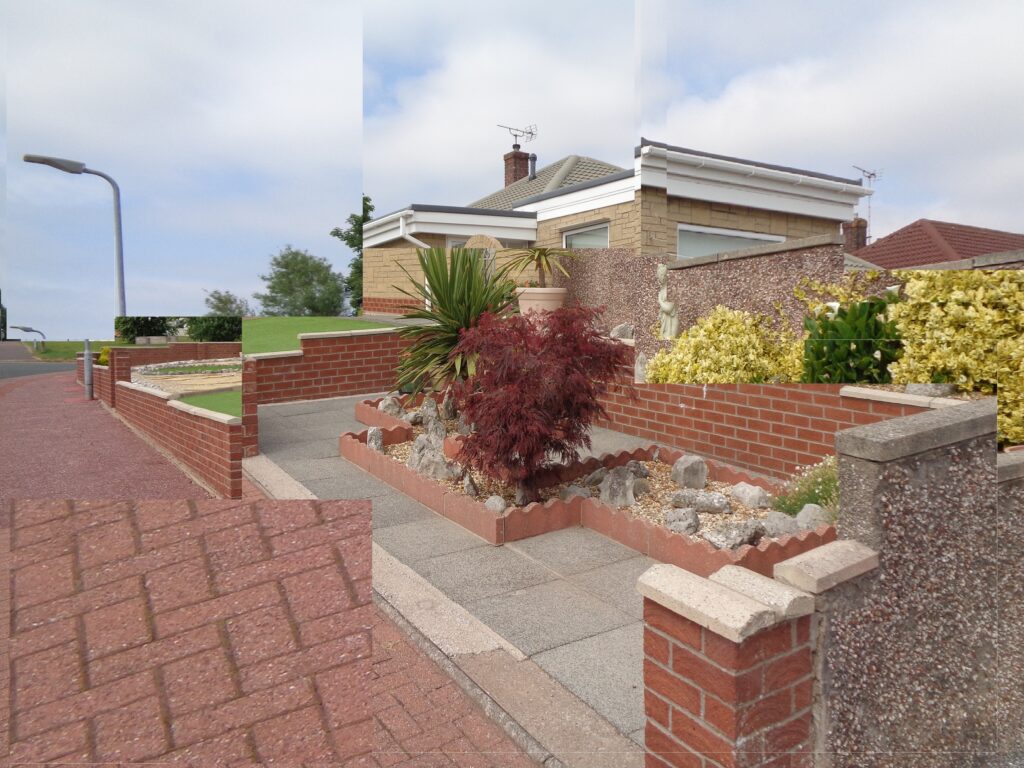
Metaphysical garden, Hawcoat estate, Barrow, 30th June 2021
As the sudden escape from child-care or release from the pressure of chores or mindless work can abruptly reveal a richness beyond daily life; beyond love become pragmatic habit; beyond chronological time dumbly accepted . . . so Hawcoat did the same to me very peaceably, from a position almost at the opposite end of the spectrum – from leisure that was almost boredom, from the contemplation of inconsequentiality, from the space of having time to kill and no expectations. Calmly, without bother, Hawcoat came upon me. Its quiet revelation emphasising still further on that auspicious Friday the 13th – when I was either confident of minor transcendence or conditioned to the idea of lightning not striking twice? – the degree to which the whole of life and society, can be just one long avoidance strategy. Perhaps only love, ideal community and the best of art and philosophy can seriously attack this evasion, this lethargy? All the rest of our work, our aims and aspirations, can’t help but pander to our daily avoidance, our predetermined way of seeing.

The Gravel Rabbit’s Dominion, June 2021
“I wrestled with reality for 35 years and I’m glad to say I finally won out over it”. So says James Stewart in the 1950 film Harvey[vi]. I remembered this film – which implies but never shows, an invisible rabbit well over 6 feet tall, mischievous yet basically benign – as charming. In fact, ‘tedious screwball’ might be a better description. Undoubtably some of the speeches and quips are good:
“Then there’s the birth trauma . . .”
“That’s the one we never grow out of . . .”
But overall, Harvey takes a safe comic route and leaves the impression that only the rich or the alcoholic can treat reality with the contempt it so often deserves.

Time warp rooftops on the brim, tell me all your stories within . . .
On a green hill above Barrow, closer to the abbey than the docks, despite the negative impression these photographs gave my four friends, Hawcoat is undoubtably a spacious estate. Adjoining the Furness General Hospital, the streets and closes are wide and open by comparison with later schemes. I’d guessed it was late 60s or early 70s and only bothered to discover two weeks after my second visit, that although the ward dates back to the middle ages, the “vast majority” was built in the 1960s “as a direct response to the expansion of Vickers shipyard.”[vii] Apparently, it was briefly referred to as “Polaris Village” after the Resolution class nuclear submarines built at the shipyard three miles downhill, each of which carried up to 16 Polaris nuclear missiles[viii].
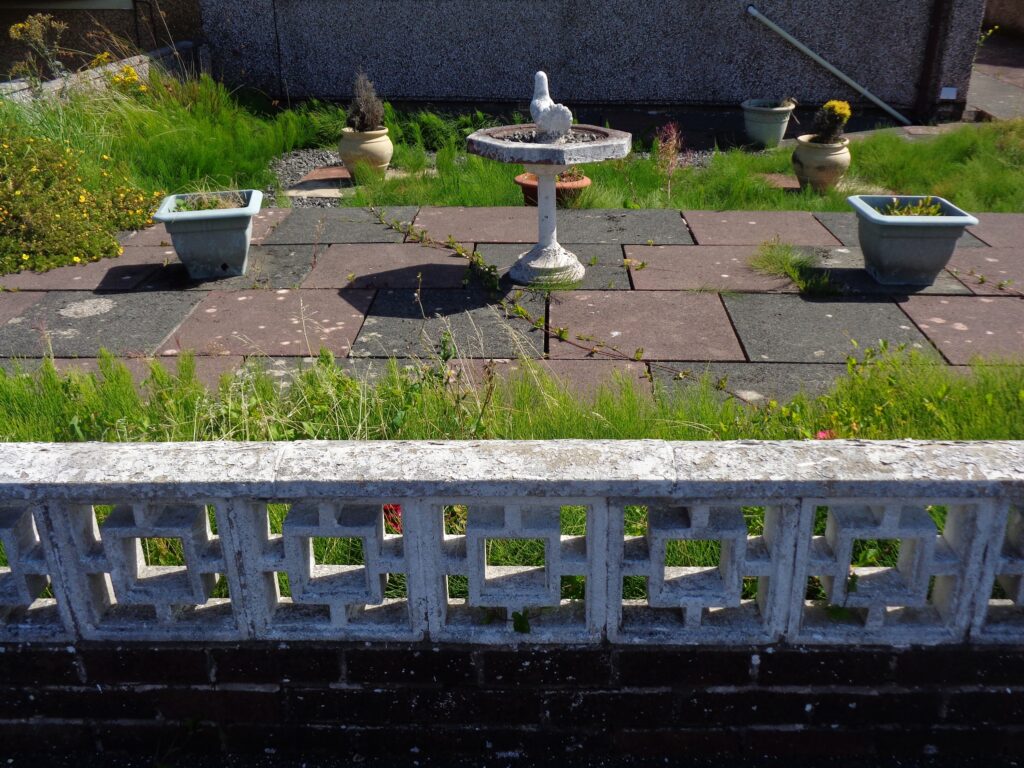
Decline and Fall of the Bold Dove’s Empire, 13th August 2021
Had there been some 80s infill on Hawcoat? What confuses the sense of period is the number of design mutilations incorporated since. Diamond leaded UPVC being possibly the most ersatz of all? Yet what – via the photographs and some brief descriptions added later – saddened one of my friends (“I think it’s mostly the idea of AstroTurf” [ix]) and horrified another, only made me happy. Perhaps I was simply in a forgiving mood thanks to the weather – drifting around in a time warp, probably deranged still further by the sheer variety of styles, the indescribably bad architectural tones. Each individual castle, empire or statement of neglect, the borders of their countries . . . Enjoying my nostalgia, I burnt freely, unclouded by the longing for pasts which never existed, gifted by those vivid particular times which often, paradoxically, lead out of time altogether.
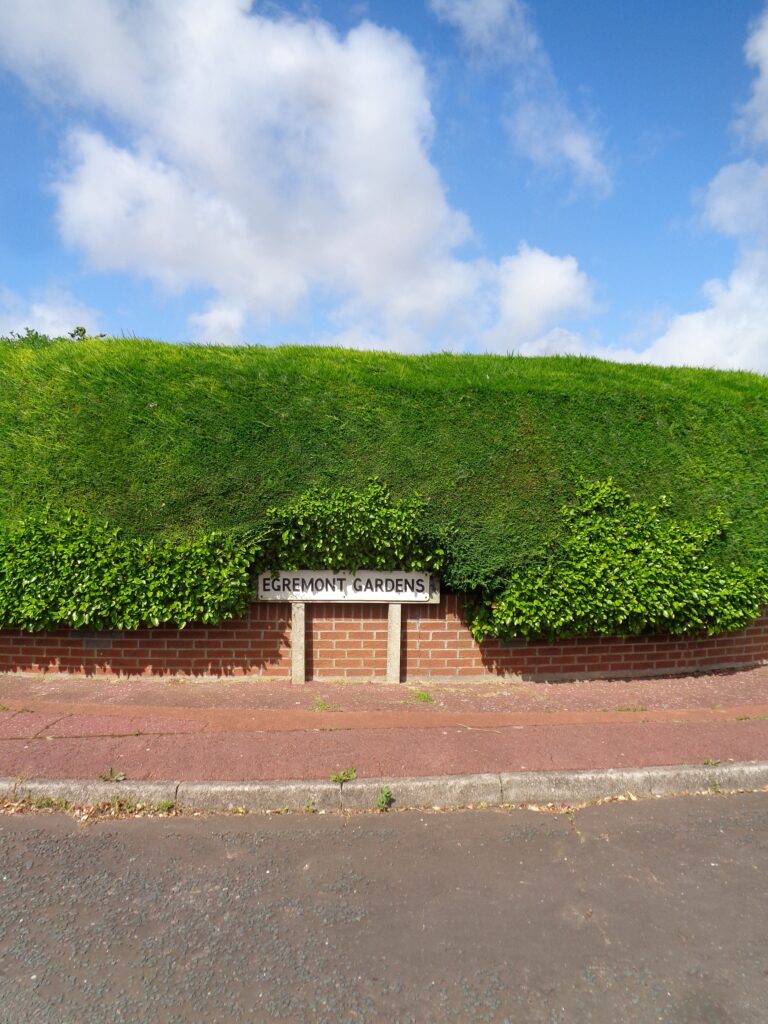
A Corner Out of Time
Standing by the gate back at home on another beautiful sunny day, in the warm breeze amongst the variegated sun and shade, waiting for the school bus to bring our youngest children home, I had the same sensation of stilled and yet passing time I remembered having as a child in our small garden on Elmhurst estate more than 50 years ago. I thought of adaptation and exile and how we learn to control and crush what we feel. Of those still living who I knew then on Elmhurst, not one person lives with 300 miles. Yet the trees, the grasses and the sky can still for the time being, calm all the exiles as they come and go.
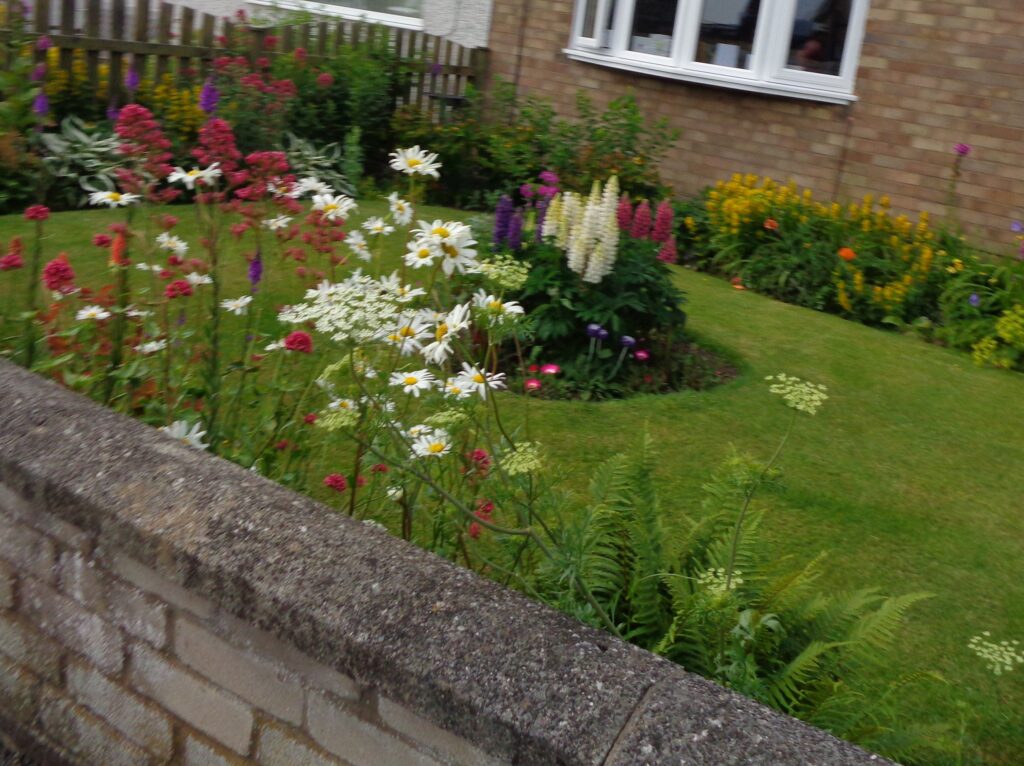
Cheering Crowds, July 2021
All feelings can come to seem an indulgence if you become too aware of them – one reason perhaps, why so many choose to die long before they die?

Singing Curves . . .
Whether we realise it or not, so many aspects of life as well as the art we favour, come down to mood, to an ambience, to a hidden language or suggestion beyond the surface. ‘The bones of this land are not speechless’[x]. That art in galleries often serves only as a sideline to the coffee shop – was that once less true? Nostalgia or a longing for the good life, a smell of turpentine, white walls and the freer windows of loose painting, the sound of the sea . . . all these things together may be as much the reason why those fascinated by the post-war art of St. Ives (to choose one distinctive example) favour it – even if the initial attraction could only have been formed by an encounter with certain paintings.[xi] For me, several of the gliding paintings of Peter Lanyon[xii] surpass all our avoidance sidelines.
Part of the reason the ambience of this Barrow suburb fascinates me must be because it recaptures the 70s in my mind . . . Those meshes of mid-morning or afternoon are always waiting for us.
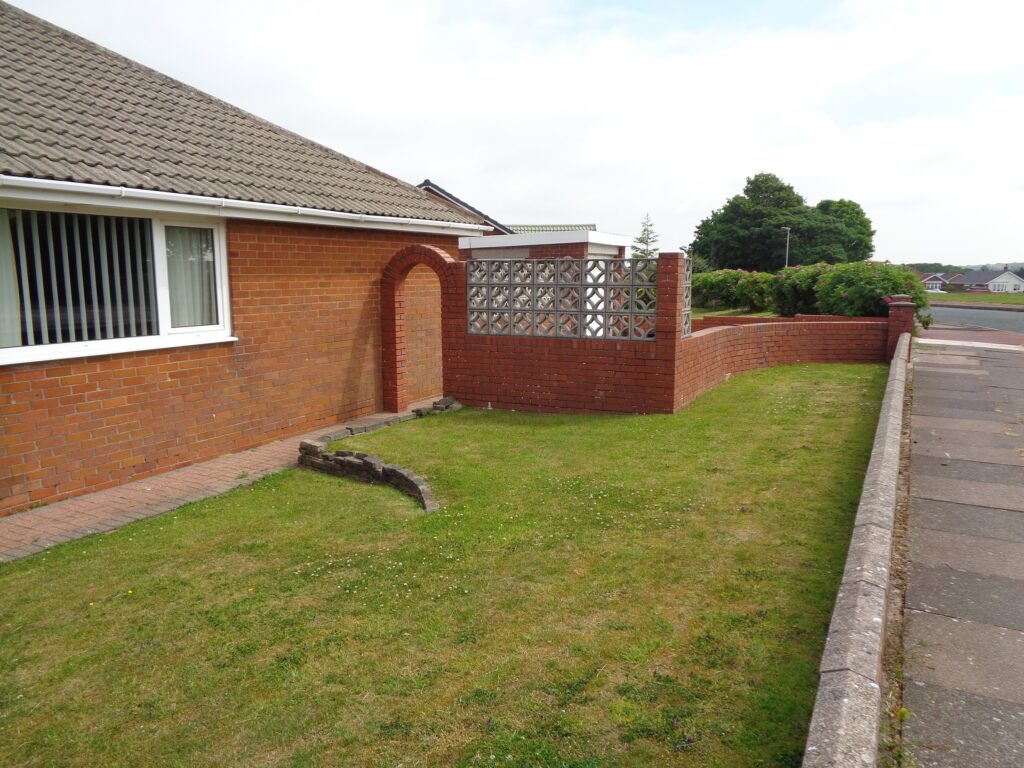
Hints and Entrances, 30th June 2021
Despite that a high percentage of the lawns on Hawcoat are false, many of its gardeners have made an immense effort: bricks and paving mathematically placed, plants standing to attention. Though I can’t entirely approve of the regimented results, I can understand the impulse to mesmerize chaos. Everyone likes the idea of freedom, even if few can cope with it. One man gave me a very friendly wave from his living room – a thumbs up when he saw me photographing his garden.
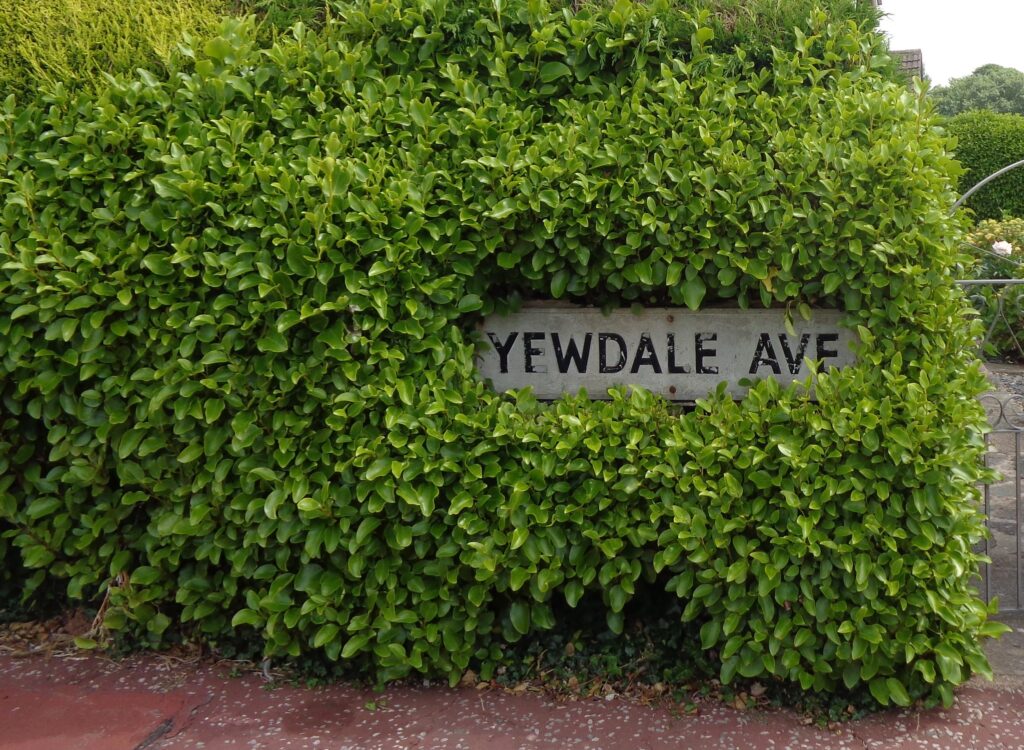
Embowered
Hawcoat was like a home I’d once had and yet wasn’t. Or maybe it was more about that lost era? That period when the nettle of ecological disaster should have been grasped. It is easy to revel in the atmosphere or aesthetics of so-called progress without realising the destruction it has caused. “The sound rises and clashing under the bridge explodes into a fast-thudding thunder and the rushing of white words on a red band, Freightliner, Freightliner, Freightliner . . .”[xiii] Even before encountering the optimistic propaganda of such British Transport Films as Freight Flow, 1969[xiv], I was inadvertently guilty of celebrating the containerisation which led to an exponential rise in world trade, becoming a tool to break the unions and further accelerating environmental breakdown in the process.

Pale maroon harbours, 30th June 2021
Horrified by the brown and beige aspects of the 70s and feeling so much more trapped by her upbringing than I ever did, one close friend of mine, finds the Hawcoat photos intensely depressing – reminding her of prescribed roles in the air: racist, homophobic, misogynistic, and patriotic. The closeness of gardens; the suspicions and hierarchies of neighbours; whose children she was allowed to play with and which to avoid – all those subtle sub-divisions within a relatively narrow class band. Then there was the regular washing of cars and the obligation to watch acres of bland TV. The background to nostalgia is often toxic. But on Hawcoat at the time I felt disinclined to consider anything so political or specific. In any case, being a decade older, the 70s are a multi-dimensional enigma to me, an orchestral time rather than a tone poem, a lived ambience rather than a half-memory or afterthought.
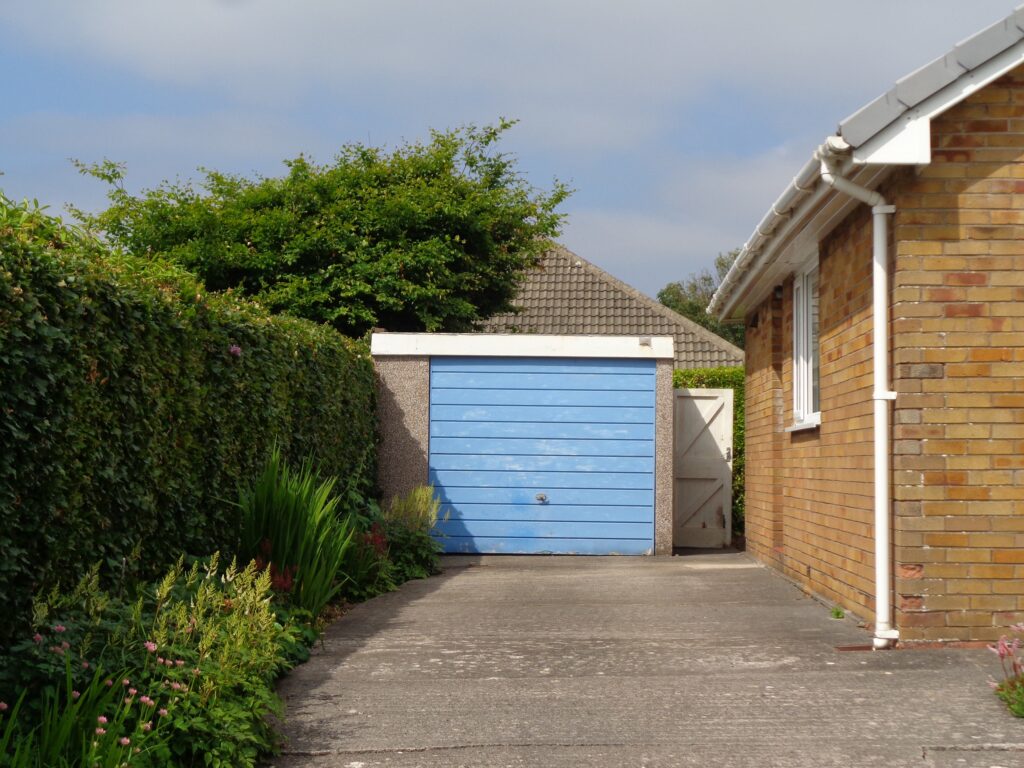
Time Indoors, 30th June 2021
Wanting to expand my theory of inadvertency as a major factor in the ongoing failure of human society[xv] a few sentences from a short profile of Mike Dibb[xvi] in March 2021’s Sight and Sound, perhaps inadvertently, illustrated the suggested decline in society over the last 50 years (due in part my dad would say to “too much bloody choice”):
“…it is clear that if Dibb were under 50 his collaborative practice would find its natural home in galleries and arthouse cinemas rather than primetime terrestrial schedules, as it did in the 70s and 80s.”
The stress here is gentle enough not to imply a criticism, yet what serious artist, would choose to preach to the converted, the investor, or the pseud, in an elitist gallery[xvii] or arthouse cinema, in preference to possibly enlightening a new audience on “primetime” television in the days when there were only 3 or 4 channels?
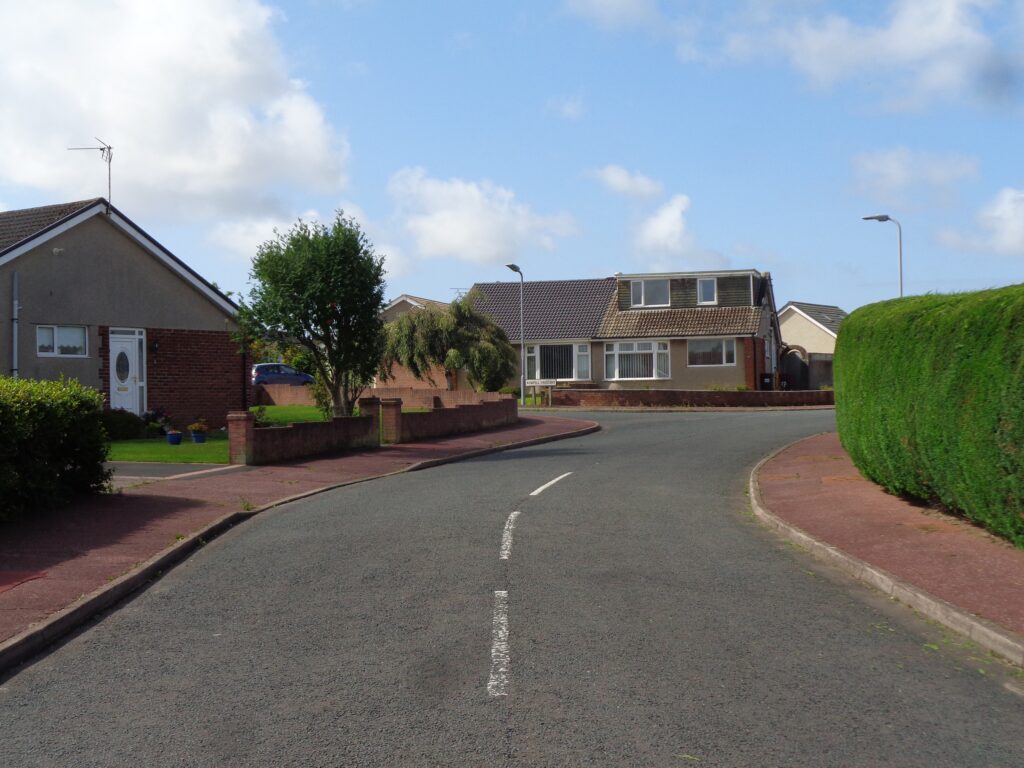
Hushed Turnings, 13th August 2021
With the rise of the internet, have we all, without fully realizing it become content with our own ghettos? . . . On the other hand, the ‘primetime’ TV referred to in the piece on Mike Dibb, was in most cases, that of BBC2 – which, in the experience of almost everyone I knew growing up on working-class, council or lower middle-class estates, was avoided like the plague. Only when the channel was lumbered with blocks of sport would anyone on Elmhurst other than my parents (always misfits) be likely to tune to BBC2. So maybe it’s only the location, depth of focus and volume of the ghettos which has changed? Putting aside the diminishing attention-span controversy, should we take comfort that the disconnection in society may only have shifted in structure?
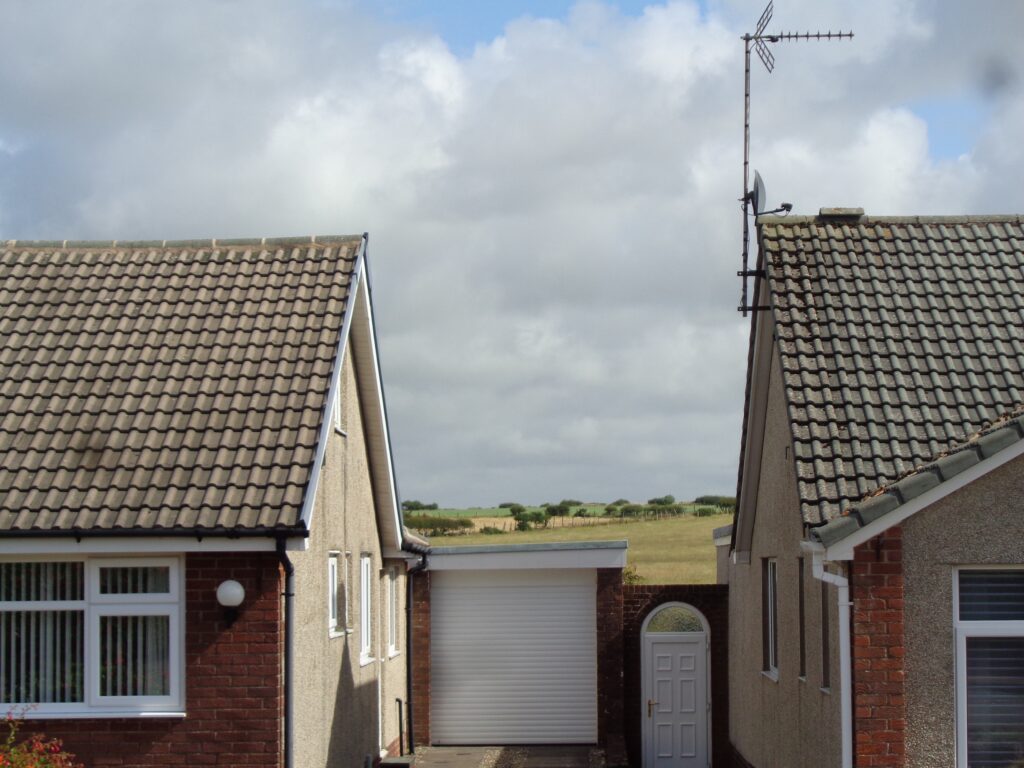
Over the fields and far away, 13th August 2021
The Hawcoat type of suburbia, heightens my sense of the lives within, the reasonable hopes that hang on a thread. Unambitious box houses with small garden areas to front and rear; streets silent from mid-morning to mid-afternoon; open fields nearby – all these take me back. Though I’m idealizing Elmhurst estate as it was then, investing it with some pacific essence of welfare and post-war hope that in reality, if it ever existed at all, began to die a decade before . . . perhaps that was the truth inside my mind, a child’s perception? The difference between subjective reality and the objective breed, is that the former has a chance to lead to some eventual insight, whereas the latter often becomes no more than an excuse for avoidance. Despite which, the better society we might have had was undermined as much by our own (subjective) instinct for consumption as it was by ‘objective’ technology’s numerous exploiters.
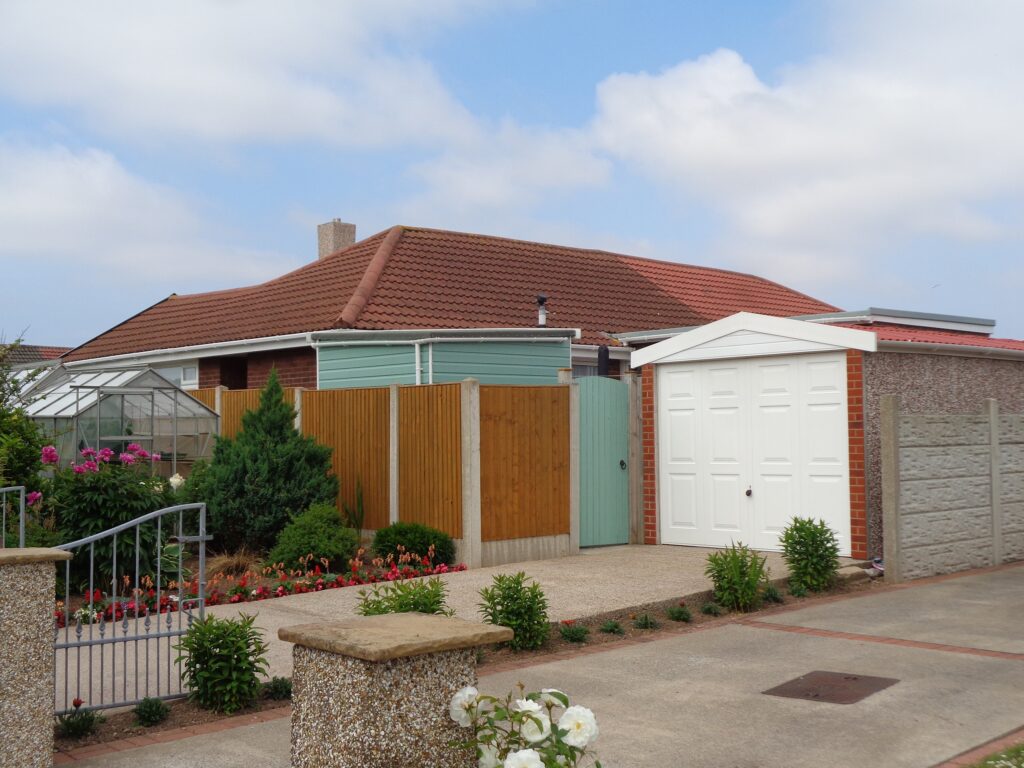
Driveways and surfaces of ordered desire, 30th June 2021
That whatever noble ruins of post-war hope lingered on, were to be ground into dust by Margaret Thatcher and her gang of crooks – whose descendants we’re still trying to shake off forty years later – does not finally indicate a conspiracy but rather an inadvertency. Is this is too gentle a conclusion? The resignation of someone who has given up on the world? Thatcher bullied and too many just followed. This was inadequacy rather than inadvertency – and it still is.
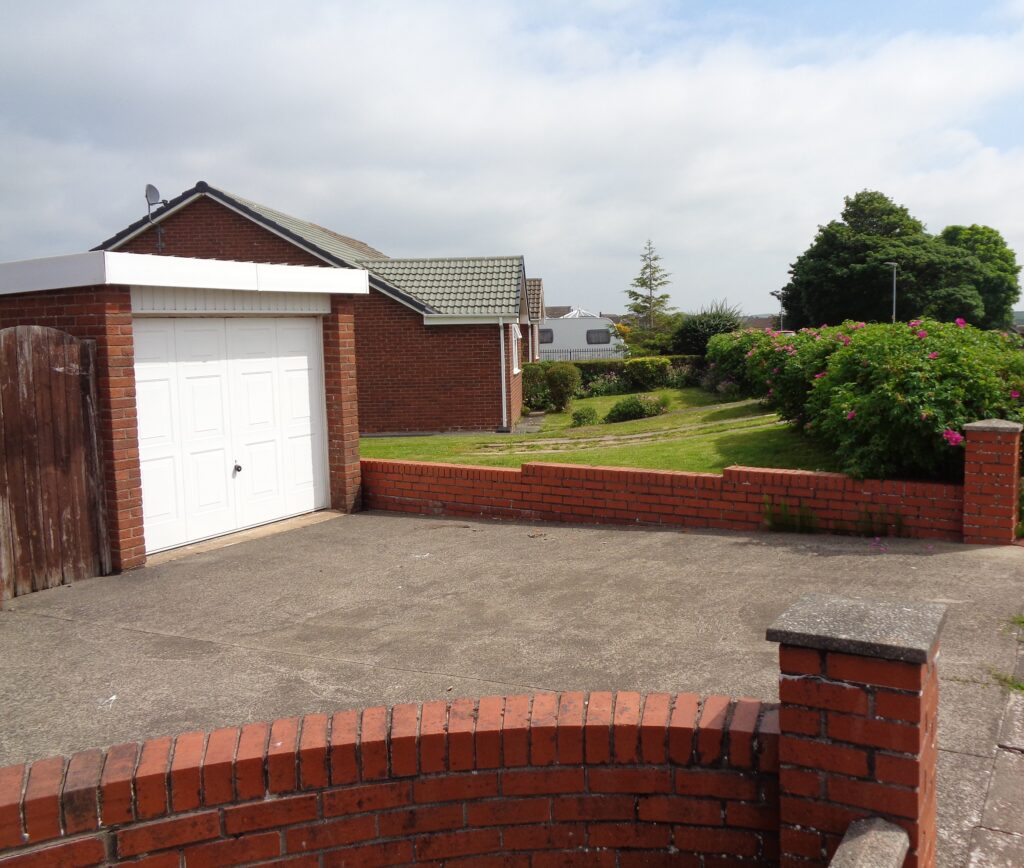
Concrete Inlet
And maybe this whole course was pre-ordained by the rationalistic poison which in the West at least, we drink at birth, a sleeping draught to kill all higher feelings, one we slavishly keep drinking, replenishing, handing on. Obviously it’s needed to some degree, it does the housework. The danger is we take it far too seriously, we give it too much respect.
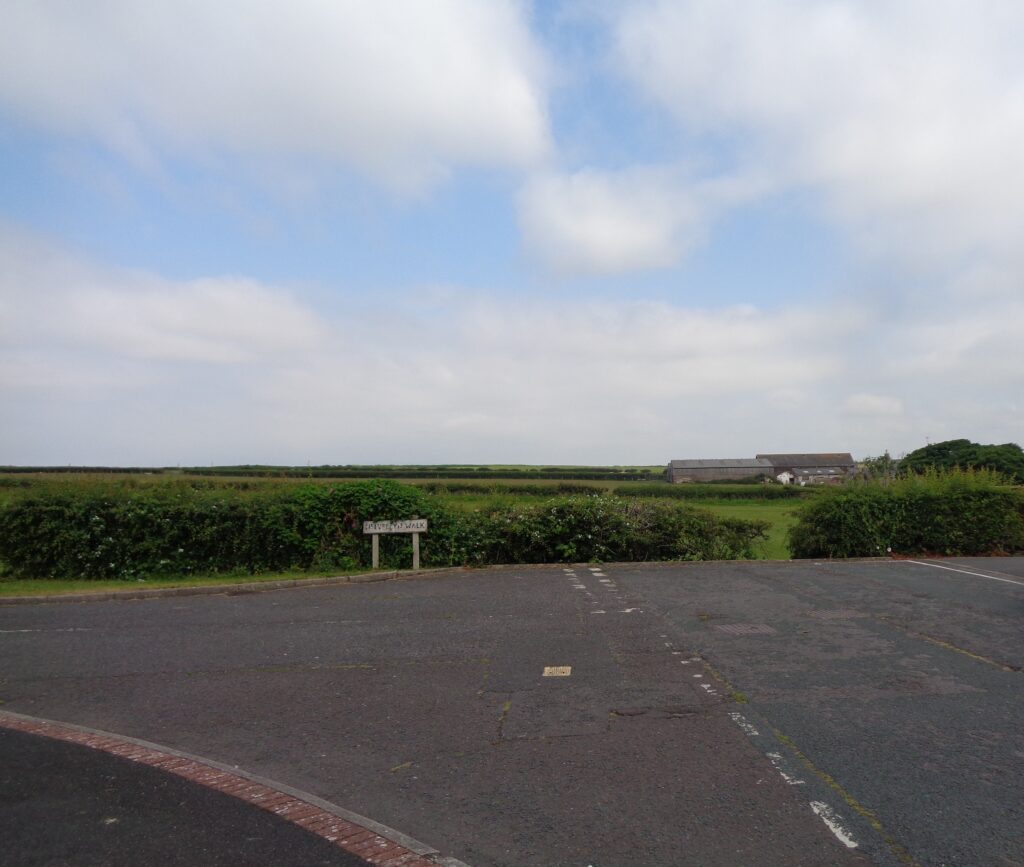
End of the road, July 2021
“Certain communities in the South Pacific responded to the breakdown of the old social order resulting from Colonialism by building runways and even wooden planes and dummy airports in the misguided hope that they would attract the goods the colonisers seemed to have in abundance”[xviii]. Somehow this sounds familiar. The myth and the misdirection.
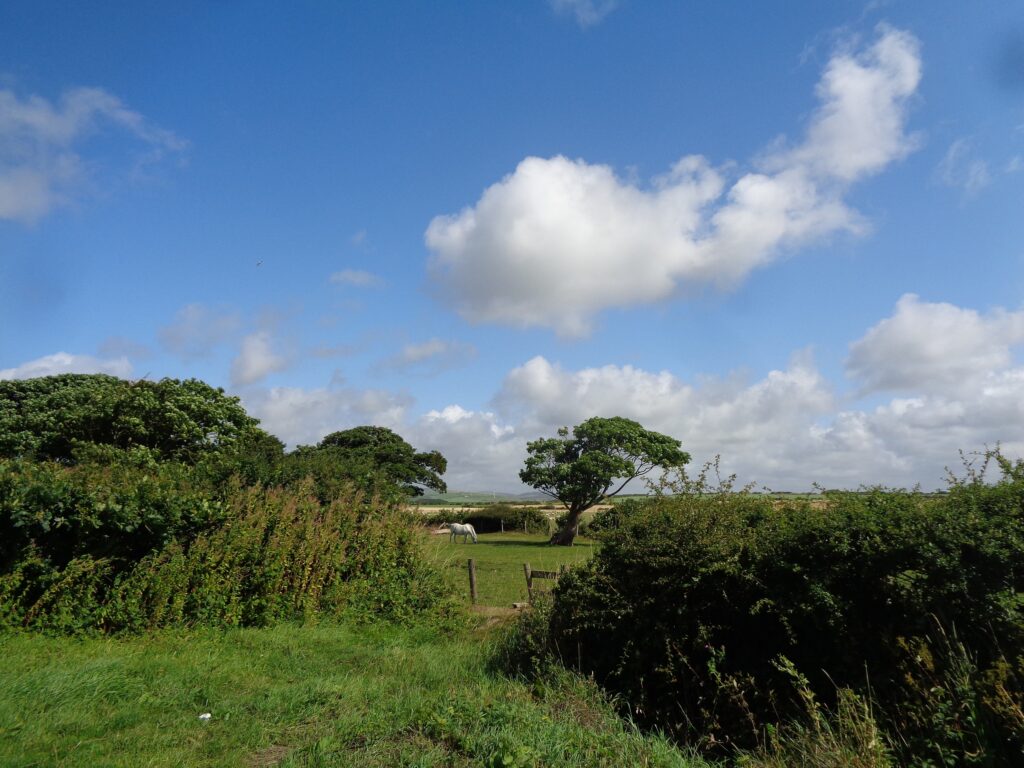
The fields beyond . . . 13th August 2021
Laughingly, observationally, in the process of leaving, perhaps Hawcoat implicates our miniaturised escape routes? The AstroTurf arenas, the bold dove and the gravel rabbit’s dominions, all play out as our lost direction, our hopes for a probably undeserved paradise.
© Lawrence Freiesleben,
Barrow (Hawcoat), Cumbria and Morecambe, July-December 2021
Almost completed in August 2021, due to a tortuous relocation, it has taken a long time to get back to this. Hawcoat now seems a lifetime away, my optimistic, semi-detached uprising of the time, hard to reach. But perhaps the harsher angle of its conclusion was always intrinsic?
NOTES All links accessed between August and November 2021
[i] See, https://internationaltimes.it/an-existential-road-trip-to-barrow-in-heavy-rain-notes-from-a-park-shelter/ published on the 31st October 2020
[ii] The Door in the Wall – a 1956 short film based on HG Welles’ story in which a man is haunted throughout his life, by a magical door that opens onto an alternate, Garden-of-Eden like world: https://www.imdb.com/title/tt0302508/
My son Kit and I saw this at the NFT in the early 2000s & were glad to have seen it, though were not greatly impressed by the “Dynamic Frame” gimmick. There are one or two instances when this much-vaunted Dynamic Frame works, but these are hardly original. Silent films did the closing-down-to-a-smaller-focussed-area virtually from their beginning – most typically with a telescope effect. Here the effect is often arbitrary, and you end up straining to see some shrunken oblong occupying a tiny portion of the screen. It’s basically a frustrating and distracting form of track and zoom. The story however, does have a certain poignancy despite both the kid and his adult form (played by the ever-unsympathetic Stephen Murray) being irritating. I suspect it’s mostly the strange colour & ambience which provides the film’s appeal? Formal flower gardens = wholeness. Book burning = bad karma. Despite The Door in the Wall’s anticipation of decline and fall . . . really it’s OK (or so we’re assured), because pompous & supercilious adult has reverted to soppy kid and can return to his 1950s, washed-out-colour, paradise.
[iii] https://en.wikipedia.org/wiki/Evening_Standard
[iv] https://en.wikipedia.org/wiki/Prebendal_Farm,_Aylesbury
[v] https://www.imdb.com/title/tt0128364/ To my mind, the best of Jissôji’s so-called Buddhist Trilogy, which also comprises of 1971’s Mandara: https://www.imdb.com/title/tt0229553/?ref_=nm_flmg_dr_30
and 1972’s, Poem: https://www.imdb.com/title/tt1033501/?ref_=nm_flmg_dr_28
[vi] www.imdb.com/title/tt0042546/?ref_=fn_al_tt_1 featuring a giant rabbit very different from that of Donnie Darko: https://internationaltimes.it/donnie-darko-a-digression-on-universality-and-inevitable-nostalgia/
[vii] https://en.wikipedia.org/wiki/Hawcoat
[viii] https://en.wikipedia.org/wiki/Resolution-class_submarine
[ix] Email from a friend: “But I have noticed the same effect walking around many residential areas recently – particularly in London suburbs – where virtually all the little front gardens have been paved over in one way or another, and so there is nowhere for the rain water to soak away, and it all cascades straight into the street gullies and away, flooding the rivers and watercourses almost immediately. Just so sad.”
[x] Frances Bellerby quoted in Britain’s Art Colony by the Sea, Denys Val Baker’s 1959 book about St. Ives and West Penwith.
[xi] Very few ‘works of art’ are good enough to escape their environment, their psychology or the subsequent celebrity of the artists who created them. Van Gogh (for example) owes much of his respect to the drama of a tortured biography.
[xii] https://en.wikipedia.org/wiki/Peter_Lanyon
[xiii] The Bow, 1983, revised & reprinted in 2000: ISBN 10: 1900152657 ISBN 13: 9781900152655
[xiv] https://www.imdb.com/title/tt3238306/
[xv] A failure compared with the ideal futures we’ve always been encouraged to dream. Of course, considering the total chaos we could have, many free democratic societies, for all their compromises and material mistakes, could be seen as an unlikely success.
[xvi] https://en.wikipedia.org/wiki/Mike_Dibb
[xvii][xvii] I speak as a painter disillusioned by galleries which tend either to serve commercial interests or follow the gimmick.
[xviii] Art and its global histories: edited by Warren Carter

Wonderful stuff – I’m also haunted by 70s estates and that odd beauty/overload, which you describe so well. Mine was in Welwyn Garden City:
Comment by Paul Sutton on 31 December, 2021 at 12:26 pmhttps://www.littermagazine.com/2021/12/paul-sutton-poem.html